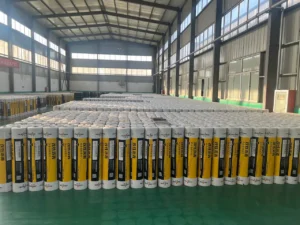When you need an adhesive or sealant, you want the best one to get the job done. If you’re building a new deck, butyl tape can add years of safety and usefulness to your home improvement. Butyl tape provides a protective barrier against the moisture and condensation that seeps through the decking boards when it rains or snows, keeping your wood stronger for the long run.
Butyl tape creates a strong protective barrier against moisture and condensation that often seeps through decking boards when it rains or snows. This helps keep the underlying wood dry and stronger for the long run.
Let’s dive into the sticky details!
What Is Butyl Tape?
Adhesives come in three main varieties: silicon-based, rubber-based, or acrylic-based. In addition, you can find both natural and synthetic rubber adhesives.
This article focuses on butyl adhesives, part of the rubber-based category. Butyl was developed to augment traditional rubber adhesives. Butyl tapes are less temperature-sensitive and maintain their stickiness at much lower temperatures than natural rubber.
With butyl rubber tape, you find a tape that instantly adheres to most surfaces and has a high adhesion level. Due to its flexibility bonds well in applications where moisture is a factor, such as with decks. In addition, homeowners and builders appreciate how quickly they can repair with butyl seal tape.
Common Uses for Butyl Tape
Butyl tape’s flexibility and durability make it versatile. Typical uses include:
-
RV repairs and camper sealing
-
Small home repairs
-
Sealing glass, metal, or ductwork
-
Protecting deck substructures like joists and beams
-
Sealing around windows and doors (though sometimes caulks are preferred after construction)
Pros and Cons of Butyl Tape
Advantages:
-
Bonds securely to even hard-to-stick surfaces
-
Less affected by temperature extremes; won’t ooze in heat
-
Applies well in various weather conditions
-
More affordable than many acrylic or silicone alternatives
-
Provides an airtight and watertight barrier
-
Flows around screws and fasteners to create tight seals
Limitations:
-
Being solvent-based, it can dissolve if exposed to strong solvents such as gasoline or turpentine
-
Poor adhesion on very rough surfaces
-
Although improved, extreme temperatures may still affect performance
Butyl tape works best during initial construction phases, especially to protect wood substructures from moisture damage that leads to rot.
Why Protect Your Deck Substructure?
Even pressure-treated wood can begin to decay in just eight to ten years if it constantly soaks up moisture. Water that trickles through tiny cracks or around screws and nails often goes unseen until joists and beams hide serious rot beneath the deck boards.
Applying a layer of butyl flashing tape-such as Trex Protect Joist & Beam Tape-gives those crucial supports a waterproof barrier. The tape seals around metal fasteners, blocking water and rust long before either has a chance to do real harm. Although the roll costs only a few dollars, the protection it offers can push your decks life well past the average.
Choosing the Right Butyl Tape: What to Look For
Butyl tapes are often seen as an all-in-one solution due to their strong adhesion and weatherproof qualities. They bond well with materials like:
-
Glass
-
Rubber roofing
-
Metal roofing (galvanized, aluminum, steel)
-
Wood
-
Plastic
When selecting butyl tape, consider:
Ease of Installation: Go for self-adhesive rolls that bond on clean, dry surfaces without tricky cutting or heavy overlaps. Watch out for material thats either too thick or too flimsy.
Durability and Warranty: Pick a rugged tape backed by a strong warranty-say Trex Protects 25-year promise-for real confidence.
Cost-Effectiveness: Dont focus only on the shelf price. Weigh the full value, including how long the tape lasts and what protection it delivers.
How to Install Butyl Tape Properly
Installing joist tape is straightforward:
-
Prepare the Surface: Ensure joists and beams are clean, dry, and free of dust or debris.
-
Apply Tape: Remove the backing and firmly press the tape directly onto the wood surface, covering all horizontal and vertical areas.
-
Finish: Cut the tape to length with a utility knife or scissors for a clean fit.
For accurate material needs, consider using a materials estimator tool specific to your project size.
Final Thoughts
As Philosopher Thomas Carlyle said, “Man is a tool-using animal. Without tools, he is nothing; with tools, he is all.” Butyl tape is the right tool to protect your deck’s underlying structure, ensuring years of durability and safety.
Don’t wait for water damage to show—invest in quality butyl tape and keep your deck strong and beautiful for decades.
For more information or to inquire about our waterproofing solutions and waterproof floor paint products, feel free to get in touch with us. We’re here to help!
- Phone: +86 138 6365 6701
- Email: Huafengwaterproof@gmail.com
- WhatsApp: +86 138 6365 6701
We look forward to assisting you with all your waterproofing needs!







